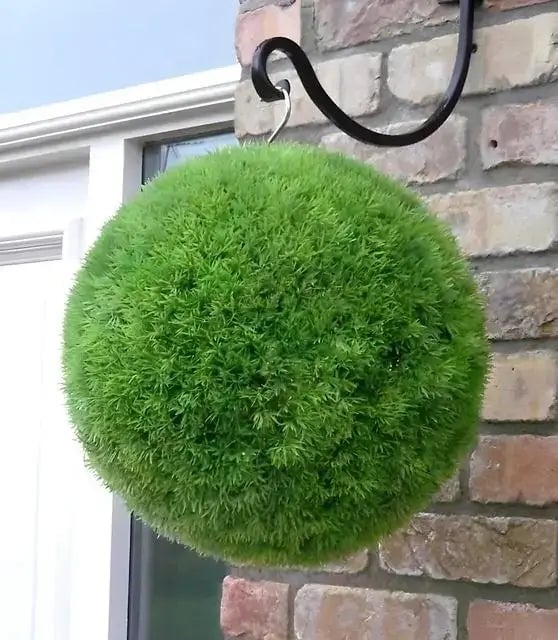



Topiary Moss
Low-maintenance, evergreen greenery all year
Enhances visual interest in landscapes
Ideal for shaded garden areas
Thrives in
ZONE 4ZONE 5ZONE 6ZONE 7ZONE 8This plant ships:
Ships Week of May 5thTopiary Moss
Topiary Moss is typically grown on frames or structures to give them an artistic and textured appearance. It is renowned for its unique and charming appearance, which offers many benefits when incorporated into landscaping designs. Its distinctive growth patterns and lush green color make it a favorite choice among landscape architects and designers. This verdant element adds a touch of whimsy and elegance to outdoor spaces, transforming them into captivating environments.
Topiary mosses, which include a range of Taxiphyllum and Sphagnum species, are adaptable plants that lend themselves to artistic expression. The ancient Greeks and Romans created topiaries to enhance their formal buildings and add charm to their landscapes. Today, gardeners often grow it on wireframes to create whimsical sculptural forms.
Habitat Of Topiary Moss
It is used in topiaries that grow all over the world. Taxiphyllum species are native to the American continents, Africa, and Southeast Asia. They grow naturally on streambanks, riverbanks, and in bogs. Sphagnums are mostly native to wet areas in the Northern Hemisphere, including peat bogs, moist tundra, woodland swamps, and conifer forests. Both kinds attach themselves to many substrates, including logs and rocks.
This and Sphagnum species come in various colors and forms and tend to have irregular branches and small, delicate leaves. The look of the plants will vary according to their species. They grow in dense mats to create a living, textured carpet of greenery that is soft to the touch. Coloration typically ranges from bright yellowish to medium green, which creates a lush display when used in large-scale projects.
Topiary Moss Is Used For Living Art
Gardeners and landscape architects often use Taxiphillum and Sphagnum to create imaginative forms that resemble animals and geometric shapes. These “living art” sculptures typically employ wireframes as invisible supports under the greenery.
Topiaries add a lively elegance to lawns, gardens, and patios. These elevated yet friendly accents are especially inviting near entrances and garden paths. They bring a cultivated and harmonious aesthetic to your landscape and add novelty and wonder to your outdoor living spaces.
Ecology Of This Stunning Native Plant
offer many ecological benefits. Taxiphillum and Sphagnum species can help oxygenate and purify the surrounding air, store carbon, and provide habitats for microorganisms. They can also help reduce noise pollution to create a more tranquil environment. Creating sculptures from Taxiphillum and Sphagnum is the perfect way to add sophistication to your landscape and give your garden a cheerful, artistic pop that everyone can enjoy. It is used to create decorative, sculpted shapes and designs in gardens.
How do you take care of it?
It grows best in an area with low light exposure, and humidity should be maintained constantly. It has to be supplied frequently with water, or it will turn pale.
How often should you water it?
It should be watered by mist if it is dry or after every few days since it is an indoor plant. Keep your plants fresh since water retention makes it easy for the plant to develop a mold or rot.
How do you identify it?
It is easily identified by its soft, spongy-like touch and its suitability for sticking into shape or literally molding into forms such as frames.
Where does it thrive?
It thrives well under shaded areas, damp areas, and areas with little exposure to sunlight. It can grow both indoors and outdoors.
Should I feed it?
Many people do not need to feed theirs due to the fact that it sucks the nutrients from the humidity within the environment. However, if you need to promote further growth, use a diluted liquid fertilizer.
This Is How Your Plants Will Look upon Delivery

Height at Maturity
Under 6 Inches
Care
Topiary Moss thrives in consistently moist, well-drained soil. Keep it watered regularly, avoiding soggy conditions. Ensure good air circulation around the plant. Trim and shape as needed to maintain its form and health. Fertilize sparingly during the growing season.
Plant Reproduction
Topiary Moss spreads by producing tiny, dense, interconnected green mats.
Choose early spring or fall when the soil is moist and cool to plant healthy bare-root ferns. You can also use dormant plants to grow year-round. When you arrive, please soak the roots in water for several hours to rehydrate them. Ferns thrive in moist and shaded areas. Dig a hole wide and deep enough to spread out the roots comfortably. Position the fern so the crown (where the roots meet the fronds) is just at or slightly below ground level. Gently backfill with soil firmly around the roots, and thoroughly water to settle the soil and eliminate air pockets. Apply a 2-3 inch layer of mulch for weed control and to retain moisture, ensuring the mulch does not touch the crown. Water during dry periods is used to keep soil moist but not soggy. Avoid fertilizing in the first year, as ferns prefer nutrient-rich soil over direct fertilization.
Shipping date depends on the date displayed and chosen when you order from the product's page.
We only accept returns on plants verified dead. If you think your plants have died, we offer a 1 year warranty, please use this File a Claim Link to verify dead plants and start with return warranty process.





Caring Tips
How do I care for my Topiary Moss?
Each box contains detailed care instructions and information about your product. But here's the basics.
Care Tips
Topiary Moss thrives in consistently moist, well-drained soil. Keep it watered regularly, avoiding soggy conditions. Ensure good air circulation around the plant. Trim and shape as needed to maintain its form and health. Fertilize sparingly during the growing season.
Light Requirements
Topiary Moss thrives in partial to full shade conditions, preferring indirect light to maintain its vibrant green color and lush texture. Direct sunlight can scorch the moss, so providing a shaded or filtered light environment for optimal growth is best.
Hardy Planting Zones
4 • 5 • 6 • 7 • 8
Header
Use this content to share information about your store and products.
Frequently Asked Questions
How often should I water my plants?
How do I know if my plant is getting too much or too little sunlight?
What should I do to prepare my plants for winter?
What are the signs that my plant needs fertilizing?
How can I prevent pests from damaging my plants?
How do I choose the right plant for my climate zone?






